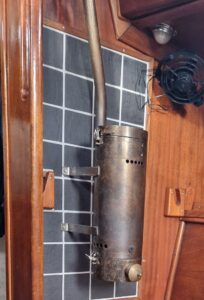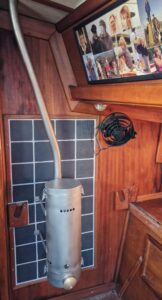This is absolutely my favourite video. You might have seen it before – and you must admit, it’s pretty spectacular: The Hampshire Heater spewing out charcoal sparks as a sort of over-blown indoor firework – and one which definitely contravenes the Health and Safety regulations.
Not only did it set fire to the bunk cushions – leaving suspicious black-tinged holes in the tartan fabric – but also it set off the carbon monoxide alarm so that I had to take out the batteries.
I know this is not recommended – but if they made the alarm a couple of hundred decibels quieter, they might save a lot more lives.
Anyway, something had to be done. It was all very well, the heater looking homely anchored off Lamin Lodge in The Gambia or at party-time in Hogs Bay, Grenada, but back in a UK winter, I was going to need it to work.
On closer inspection, it was never going to work. The whole of the combustion chamber – a caste iron cylinder inside the stainless steel outer casing, was corroded away to nothing. This meant the burning embers could exit directly through the ventilation holes and land playfully on the cushions.
I started looking at alternatives. Actually, I started looking at alternatives in a cabin temperature of 35°C, which, you will agree, was somewhat over-enthusiastic.
The good thing about charcoal is that it is carbon-neutral (the trees having already contributed to the global-cooling equation when they were growing). However, nobody makes charcoal heaters for boats anymore – not Pansy; not Hampshire.
Now, it’s all Chinese forced-air heaters – the much cheaper version of Eberspacher and Webasto. However, not only do they use diesel; they also use electricity – and on a short, cloudy, windless English winter’s day in Walton Backwaters, there isn’t much of that about.
I did like the idea of solid fuel. Tom Cunliffe has a couple of hundredweight of caste iron wood stove glowing away in the corner of Constance’s saloon (and another few hundredweight of fuel bunkered away behind the engine). In 32ft, I don’t have the space. It would have to be the Newport bulkhead-mounted thingy.
Twenty years ago, I would just have ordered one. Now, you check out these things on YouTube and, to me, they looked terribly flimsy. Also, a lot of people claimed they were fiddly to keep going and didn’t really put out much heat.
I could see myself cursing it. Besides, I didn’t know where I was going to end up. Samsara’s previous owner wintered his new boat north of the Arctic Circle (with a Refleks).
Ah, the Refleks; the heater of choice for Danish fisherfolk in the Heligoland Bight. They do a little bulkhead-mounted version – which even comes with the optional extra of a tube to draw in cold air from floor level.
I ordered one. I fixed a date for Lockgate Stoves to come and install it. I even sent a deposit towards the almost £3,000 bill (all those optional extras).
It was only the next morning, checking the depleted bank balance, that I remembered: Having removed the old Hampshire contraption in order to get accurate measurements, I had taken it to the local metalwork shop – as in: “I don’t suppose you could do anything with this…”
“Blimey, what is it?”
They never called back. I forgot all about it.
It was, as I say, only the depleted bank account that jogged my memory. I phoned them. “Yes, all ready for you,” was what they said.
And it was – welded together inside (or brazed, I wouldn’t know). Anyway, it looked as good as new.
Actually not. After years of being heated until the whole thing glowed, the once-gleaming stainless steel had been burnished to the colour of caramelised toffee.
I rubbed at it with some sort of blue paste that came with the boat. I painted it with a patented liquid that requires rubber gloves and breathing apparatus. In the end, I searched on Google for “metal polisher near me” and ended up in Hay-on-Wye at a motorcycle restorer who had a machine that blasted salt crystals at hundred-year-old two-stroke engine blocks. They turned my heater into something that looked like an exhaust pipe. In fairness, they had warned me it wouldn’t be shiny; but I hadn’t really imagined the effect of matt grey on a metal cylinder with a pipe sticking out of one end – definitely an exhaust pipe. Still, it was clean. It looked like new (a new exhaust pipe).
And it came out at less than £300 – a tenth of the diesel thing.
And I’ll be carbon-neutral again. One day, I’ll fire it up and see if it works. I’d do it tonight; only I’ve had to move off the boat so they can gut the cabin. At the moment, I’m living in a Ford Transit camper van.
Remind me to tell you about that sometime. The first thing I had to do was buy it a new exhaust pipe…

Before…

After

In 1984 I just managed to buy the Blake/Whisstock 37ft gaff cutter Mirelle and scraping together my last hundred quid I bought a Shipmate Skippy at their stand (yes, really!) at the Earl’s Court Boat Show. It was retired twenty odd years later in favour of a much more up market Shipmate discarded by a very gorgeous Rhodes cutter that arrived on the Deben. It behaved very well on a diet of Coalite in paper bags.